Ozarelix (CAS No. 295350-45-7) | Research-Grade GnRH Antagonist Peptide Supplier
原价为:$28.00。$22.00当前价格为:$22.00。
Ozarelix (CAS No. 295350-45-7) is a GnRH antagonist peptide that inhibits GnRH receptor signaling. It is widely used in prostate cancer research, reproductive endocrinology, and oncology models where suppression of gonadotropins and sex steroids is required.
描述
Product Description
Introduction to Ozarelix
Ozarelix, also referred to by its development code D-63153, is a synthetic gonadotropin-releasing hormone (GnRH) antagonist designed to inhibit the activity of natural GnRH at its receptor. Unlike agonists such as Histrelin or Leuprolide, which initially stimulate GnRH receptor signaling before desensitization, Ozarelix works by immediately blocking receptor activity. This results in rapid suppression of luteinising hormone (LH), follicle-stimulating hormone (FSH), and sex steroids such as testosterone and estradiol.
The peptide’s unique activity makes it a critical tool in oncology and endocrinology research, especially in models of androgen-driven cancers and gonadotropin-dependent conditions.
Historical Development
GnRH antagonists were developed to overcome the “flare effect” seen with GnRH agonists. When an agonist is first introduced, there is a transient spike in gonadotropin release, leading to a temporary increase in sex hormones. This can be problematic in prostate cancer research, where androgen surges may accelerate tumor progression. Ozarelix provides immediate suppression, avoiding this flare.
Applications in Research
-
Prostate Cancer: Ozarelix is extensively used in androgen deprivation studies. By lowering testosterone levels without flare, it enables cleaner models of androgen-sensitive tumor growth and regression.
-
Endocrinology: The compound is applied in studies of gonadotropin suppression and feedback mechanisms in the hypothalamic-pituitary-gonadal (HPG) axis.
-
Gynecological Oncology: Research on estrogen-driven tumors, such as endometrial and ovarian cancers, also benefits from the hormone suppression achieved by GnRH antagonists.
-
Cell Cycle and Apoptosis Studies: Beyond hormonal regulation, Ozarelix has been observed to induce cell apoptosis and arrest cell cycle progression in the G2/M phase, expanding its relevance to general oncology research.
Research Importance
The ability of Ozarelix to directly inhibit GnRH signaling without the complications of agonist-induced hormonal spikes makes it an indispensable agent for translational and preclinical studies. Its potency, selectivity, and predictable activity profile offer researchers a reliable tool to study hormonal regulation, tumor growth suppression, and mechanisms of programmed cell death.
Product Specifications
| Parameter | Details |
|---|---|
| Product Name | Ozarelix |
| CAS Number | 295350-45-7 |
| Synonyms | D-63153, GnRH antagonist peptide |
| Molecular Formula | C80H105ClN18O14 |
| Molecular Weight | 1511.3 g/mol |
| Appearance | White to off-white lyophilized powder |
| Purity | ≥ 98% (HPLC) |
| Sequence | Synthetic GnRH antagonist sequence |
| Solubility | Soluble in water, DMSO, PBS |
| Stability | ≥24 months at –20°C (lyophilized); solutions stable short-term |
| Storage Conditions | Store at –20°C, protect from light and moisture |
| GMP Compliance | Manufactured under GMP guidelines |
| Applications | Prostate cancer, endocrine suppression, apoptosis research |
| Availability | Bulk and research-grade packaging available |
Notes on Specifications
-
High Purity: Confirmed by analytical HPLC and MS characterization.
-
Stability: Lyophilized peptide ensures maximum storage life for long-term studies.
-
Batch Traceability: Full analytical data available for reproducibility in regulated labs.
Mechanism of Action & Research Applications
Mechanism of Action
Ozarelix binds to the GnRH receptor but does not activate it, functioning as a competitive antagonist. This prevents the receptor from binding endogenous GnRH, thereby blocking downstream signaling cascades that normally stimulate the release of LH and FSH from the pituitary.
The downstream effects include:
-
Decreased testosterone levels in males (via reduced LH stimulation of Leydig cells).
-
Decreased estrogen/progesterone levels in females (via reduced FSH stimulation of ovarian follicles).
-
Suppression of gonadotropin-dependent tumor growth in experimental cancer models.
Additionally, Ozarelix demonstrates direct cellular effects, including:
-
Induction of apoptosis – activation of caspase-mediated cell death pathways.
-
Cell cycle arrest at G2/M phase – halting proliferation of cancer cells.
Research Applications
-
Oncology Models – Prostate, breast, and ovarian cancer models for androgen/estrogen suppression.
-
Endocrinology Studies – HPG axis regulation and hormone feedback loop analysis.
-
Cell Death Studies – Elucidation of apoptosis pathways in peptide-treated cancer cells.
-
Pharmacology – Benchmarking against other GnRH antagonists such as Degarelix and Cetrorelix.
-
Drug Development – Preclinical tool for developing next-generation hormone suppression therapies.
Translational Importance
Ozarelix has been studied in early-phase clinical research, demonstrating its potential as a therapeutic agent in prostate cancer. In the laboratory, it remains a gold-standard model for understanding the biology of GnRH antagonism, cell cycle control, and apoptotic pathways.
Side Effects (For Research Context Only)
Potential observations in preclinical research include:
-
Hormone Suppression: Rapid and sustained lowering of testosterone and estradiol.
-
Cellular Stress: Apoptotic changes in sensitive cell lines.
-
Local Reactions: Injection-site irritation in animal models.
-
Species Variability: Differences in GnRH receptor distribution across experimental animals.
-
Bone and Metabolism Effects: Long-term hormonal suppression may alter bone mineral density and metabolic balance.
These effects are significant in research contexts, offering insights into both therapeutic benefits and biological consequences of hormone deprivation strategies.
Disclaimer
For laboratory research use only. Not for human or veterinary use.
Keywords
- Ozarelix CAS 295350-45-7
-
Ozarelix peptide supplier
-
GnRH antagonist peptide
-
Ozarelix prostate cancer research
-
D-63153 peptide
-
GnRH receptor inhibition
-
Ozarelix apoptosis research
-
Ozarelix androgen deprivation studies
-
Research-grade GnRH peptide supplier
其他信息
| 重量 | 0.8 公斤 |
|---|---|
| 尺寸 | 52 × 63 × 52 厘米 |
Ozarelix (D-63153) is a GnRH antagonist peptide.
CAS No. 295350-45-7.
It competitively blocks GnRH receptors, preventing gonadotropin release.
C80H105ClN18O14.
1511.3 g/mol.
Prostate cancer, endocrine suppression, apoptosis studies.
Yes, it has been observed to induce apoptosis and G2/M arrest in cancer cells.
It avoids the initial hormone “flare” caused by agonists.
≥ 98% (HPLC).
No, it is for laboratory research use only.

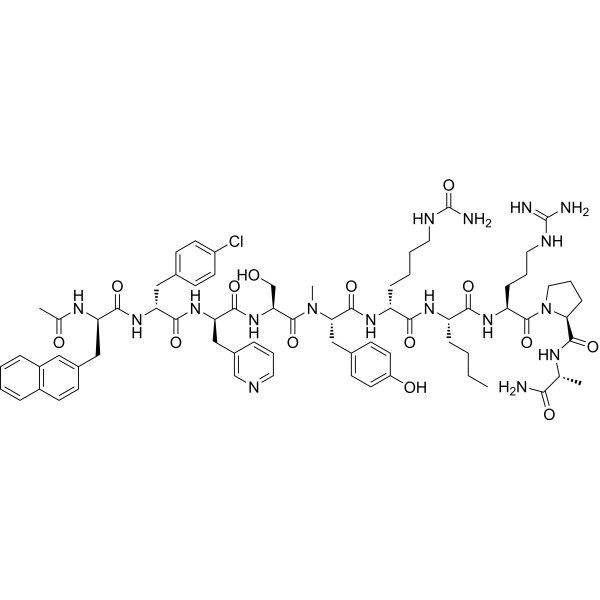







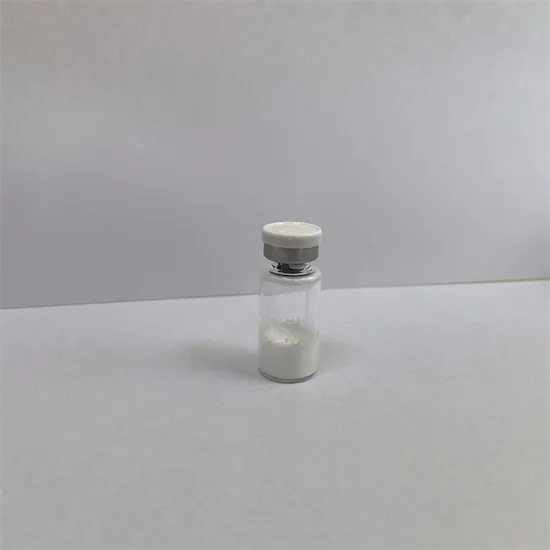
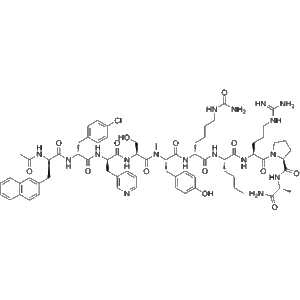
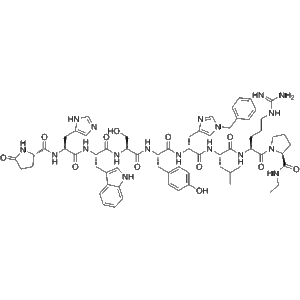
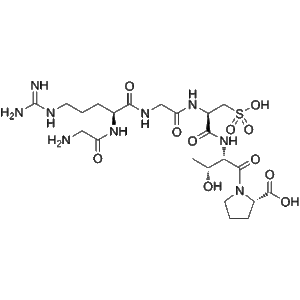
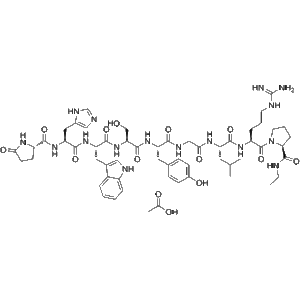

评价
目前还没有评价